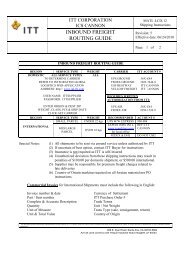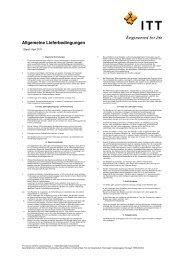CTA - ITT Cannon
CTA - ITT Cannon
CTA - ITT Cannon
Create successful ePaper yourself
Turn your PDF publications into a flip-book with our unique Google optimized e-Paper software.
Strip Connectors - .100"/.075" Contact Spacing<br />
<strong>CTA</strong><br />
CENTI-LOC connectors are low-cost nylon strip<br />
connectors designed for commercial applications<br />
such as instrumentation, communications,<br />
and medical equipment. They are available<br />
in continuous strip form up to a maximum<br />
length of 6 inches (152.40mm), accommodating<br />
from 1 to 60 rear insertion, front<br />
release, crimp snap-in size 22 CENTIPIN TM /<br />
CENTISOCKET TM contacts. These contacts utilize<br />
a proven positive contact alignment<br />
design, giving additional contact strength and<br />
positive contact alignment during mating.<br />
These connectors can be ordered in kit or bulk<br />
form. The kit comprises all the parts necessary<br />
to assemble one complete 6-inch (152.40)<br />
strip connector with 60 contacts on .100<br />
(2.54) centers or a 4-inch (101.60mm) strip<br />
with 53 contacts on .075 (1.91) centers. If<br />
more then one connector is required, the<br />
parts can be ordered in bulk and assembled as<br />
desired.<br />
Components and Accessories<br />
The CENTI-LOC strip connector can be ordered in<br />
kit or bulk form. The kit includes matin g insulators<br />
with a full compliment of contacts and two guide<br />
posts. If more than one connector is required, the<br />
parts can be ordered in bulk and assembled as<br />
desired.<br />
Kit Form<br />
Kits include mating insulators with full<br />
complement of contacts and two guide posts.<br />
Part<br />
Contact<br />
Number Center spacing<br />
<strong>CTA</strong>3-KIT<br />
.075 (1.91)<br />
<strong>CTA</strong>4-KIT<br />
.100 (2.54)<br />
<strong>CTA</strong>3-<strong>CTA</strong>4-KIT .075 (1.91) & .100 (2.54)<br />
Insulator<br />
.275 (6.98)<br />
MAX.<br />
Guide Posts<br />
Polarizing Posts<br />
The guide posts and polarizing posts are inserted in the same manner as the contacts. The guide<br />
posts are inserted into the socket insulator and the polarizing posts are inserted into the pin<br />
insulator. The corresponding contact in the mating insulator must be removed for each.<br />
See assembly instructions.<br />
.475 (12.06)<br />
MAX.<br />
Insulator<br />
Guide Post<br />
Polarizing Post<br />
Part<br />
Number<br />
<strong>CTA</strong>3-IP-53<br />
<strong>CTA</strong>3-IS-53<br />
<strong>CTA</strong>4-IP-60<br />
<strong>CTA</strong>4-IS-60<br />
<strong>CTA</strong>-GP<br />
<strong>CTA</strong>-PP<br />
Contact<br />
Center<br />
Spacing Type Material<br />
.075 (1.91)<br />
Pin<br />
.075 (1.91) Socket<br />
.100 (2.54)<br />
Pin<br />
.100 (2.54) Socket<br />
P/N 230-9507-000<br />
P/N 230-9506-000<br />
Nylon<br />
Nylon<br />
Nylon<br />
Nylon<br />
Passivated Stainless Steel<br />
Passivated Stainless Steel<br />
D<br />
.115 (2.92)<br />
MAX.<br />
Weights<br />
Part<br />
Number<br />
<strong>CTA</strong>3<br />
<strong>CTA</strong>4<br />
Dimensional Data<br />
4.031 (102.39)<br />
MAX.<br />
.040 (1.02) MIN. .040 (1.02) MIN.<br />
.075 (1.91)<br />
TYP.<br />
<strong>CTA</strong>3-.075(1.91) Centers<br />
No. of<br />
Contacts<br />
53<br />
60<br />
Contacts<br />
Type<br />
pin<br />
socket<br />
pin<br />
socket<br />
.115 (2.92)<br />
MAX.<br />
6.031 (153.19)<br />
MAX.<br />
.100 (2.54)<br />
TYP.<br />
<strong>CTA</strong>4-.100(2.54) Centers<br />
Avy. Weight<br />
oz.<br />
.185<br />
.203<br />
.230<br />
.241<br />
± 5%<br />
gm.<br />
5.25<br />
5.75<br />
6.30<br />
6.90<br />
Microminiature<br />
Dimensions shown in inches (mm)<br />
Specifications and dimensions subject to change<br />
www.ittcannon.com<br />
D-85
The Centi Line - .075" Contact Spacing<br />
2D/<strong>CTA</strong><br />
Contacts<br />
A resilient internal shoulder retains the contacts in the<br />
insulator housing. The front of the contact is chamfered<br />
to prevent damage to the internal shoulder as the<br />
contact is pushed into position.<br />
P.C. Tail Contacts<br />
Subtract .064 (1.63) +_ .010 (.25) from pigtail<br />
length when used in 2D pin insulator for potting<br />
well of connector assembly.<br />
Subtract .081 (2.08) +_ .010 (.25) from pigtail<br />
length when used in 2D socket insulator for<br />
potting well of connector assembly.<br />
Contact Part Number<br />
Part Number<br />
Pin<br />
031-9540-000<br />
031-9540-004<br />
031-9540-005<br />
Socket<br />
030-9542-001<br />
030-9542-002<br />
030-9542-004<br />
Type<br />
Standard 30µin. plating<br />
50µ in. plating<br />
With inspection hole;<br />
Pin Socket<br />
50µ in. plating<br />
N/A 030-9542-011 P.C. tail<br />
.026 dia. x .083 lg. Soc.<br />
*031-9540-013 030-9542-012 P.C. tail<br />
.183 lg. Soc.<br />
.020 dia. x<br />
.183 lg. Pin<br />
031-9540-016 030-9542-014 Long crimp<br />
barrel **<br />
031-9540-022<br />
***<br />
031-9540-007<br />
*031-9540-015<br />
030-9556-000<br />
***<br />
030-9542-022<br />
030-9542-015<br />
Small crimp bore<br />
For AWG #32 & 30<br />
Small crimp bore<br />
For AWG #28 & 30<br />
P.C. tail<br />
.232 lg. Soc.<br />
.020 dia. x<br />
.255 lg. Pin<br />
*031-9540-019 030-9542-016 P.C. tail<br />
.444 lg. Soc.<br />
.018 dia. x<br />
.445 lg. Pin<br />
50µ in. plating<br />
NOTE: Plating, except as noted, is 30 micro-inch gold.<br />
* Consult factory for any tail size or plating requirements.<br />
** Special crimp locator required. Part number: 995-0001-714. (L3198-CL-PSL)<br />
*** Use special insertion tip (323-9510-016 &-017).<br />
2D and Centi-Loc Crimp and Assembly Tools<br />
Tool<br />
Pin<br />
Locators<br />
Socket<br />
Description<br />
Part Number<br />
M22520/2-01<br />
995-0001-584<br />
L3198-CLP<br />
995-0001-338<br />
L3198-CLS<br />
995-0001-353<br />
D<br />
Microminiature<br />
CIET-<strong>CTA</strong><br />
Handle<br />
M22520/2-01<br />
Insertion Tips<br />
<strong>CTA</strong>-AB<br />
Assembly Holding<br />
Block<br />
Part Number: 328-9508-000<br />
Insertion Tools For Standard Contact<br />
AWG<br />
Size*<br />
22<br />
24<br />
26<br />
28<br />
30/P.C. Tail<br />
CIT-PS-<strong>CTA</strong>-22<br />
323-9510-001<br />
204-9500-000<br />
CIT-PS-<strong>CTA</strong>-24<br />
323-9510-002<br />
204-9500-000<br />
CIT-PS-<strong>CTA</strong>-26<br />
323-9510-003<br />
204-9500-000<br />
CIT-PS-<strong>CTA</strong>-28<br />
323-9510-004<br />
204-9500-000<br />
CIT-PS-<strong>CTA</strong>-30<br />
323-9510-005<br />
204-9500-000<br />
* Based on wire size per MIL-W-16878 with Type E insulation, use smaller tool for wire with thin<br />
insulation, larger tool for wire having thick insulation.<br />
** The 5 insertion tips (part numbers 323-9510-001 thru - 005). plus handle, and the pin and socket<br />
extaction tips maybe ordered as a SINGLE KIT by specifying the part number CIET-<strong>CTA</strong>-2.<br />
[Part number: 070143-0002].<br />
Insertion Tools For Long Crimp barrel Contacts<br />
AWG<br />
Size*<br />
22<br />
24<br />
26<br />
Kit Part Number<br />
(handle and tip)<br />
Tip Part Number ***<br />
Pin Contact<br />
323-9510-008<br />
323-9510-009<br />
323-9510-010<br />
Tip<br />
Part Number**<br />
Tip Part Number ***<br />
Socket Contact<br />
323-9510-012<br />
323-9510-013<br />
323-9510-014<br />
Handle<br />
Part Number***<br />
204-9500-000<br />
204-9500-000<br />
204-9500-000<br />
*** To order the SINGLE KIT for the long crimp barrel contact (tip part numbers 323-9510-008 thru<br />
-014, handle and pin and socket extraction tips) please specify CIET-<strong>CTA</strong>-3.<br />
Handle<br />
Part Number**<br />
Socket Extraction<br />
Tip<br />
Pin Extraction<br />
Tip<br />
Extraction Tools<br />
Contact<br />
CENTIPIN<br />
CENTISOCKET<br />
Description<br />
CET-P-<strong>CTA</strong>-2<br />
CET-S-<strong>CTA</strong>-1<br />
Kit Part Number<br />
(handle and tip)<br />
070112-0002<br />
070113-0001<br />
Tip Part<br />
Number<br />
324-9502-000<br />
324-9501-000<br />
Handle Part<br />
Number<br />
204-9500-000<br />
204-9500-000<br />
D-86<br />
Dimensions shown in inches (mm)<br />
Specifications and dimensions subject to change<br />
www.ittcannon.com
The Centi Line - .075" Contact Spacing<br />
2D/<strong>CTA</strong><br />
2D/<strong>CTA</strong> CENTI-LOCTM Connectors Assembly Instructions<br />
The Double Density D/<strong>CTA</strong> CENTI-LOC Connectors are<br />
highly reliable and simple connectors to use. There<br />
are a few helpful suggestions that will assure complete<br />
satisfaction when followed:<br />
1. The following instructions should be followed.<br />
2. The proper crimp tool and locator (if required)<br />
must be used. These tools have been designed<br />
for use with this product. Substitutions of crimping<br />
equipment may result in connector failure at<br />
the assembly operation.<br />
3. After crimping a contact to a lead it is of vital<br />
importance that the proper tool be used to<br />
assure seating the contact in the insulator in the<br />
proper position. Any substitution of insertion<br />
tools may result in over or under insertion of the<br />
contact which may damage the retention system<br />
of the insulator.<br />
2D Assembly Instructions<br />
4. The female (socket) side of the connector has<br />
been designed with a controlled float to allow for<br />
ease of mating. To avoid reducing this float or<br />
causing a splaying of the contacts, any unnecessary<br />
strain caused by clamping the leads too close<br />
to the rear of the connector should be avoided.<br />
Use of recommended tooling together with proper<br />
assembly techniques will pay dividends in reliability<br />
and reduced costs.<br />
WIRE STRIPPING<br />
CONTACT CRIMPING<br />
.100<br />
(2.54)<br />
Cut the wires to length required and strip .100" of<br />
insulation from the end to be crimped. Check for<br />
cut or broken wires and frayed insulation.<br />
CONTACT INSERTION<br />
Using the proper crimp tool and locator, insert the<br />
contact into the locator. Insert the stripped end of the<br />
wire into the contact crimp pot, and crimp the contact to<br />
the wire. Squeeze the handles firmly to insure a proper<br />
crimp (tool will not release if crimping is incomplete).<br />
NOTE: Contact stop must be changed in tool locator<br />
when crimping pin and socket contacts.<br />
1. Place the proper insertion tip in the<br />
insertion/-extraction handle and put the tip over the<br />
wire as shown. The tool tip will butt up against the<br />
crimp pot. Connector must be firmly supported<br />
during both insertion and extraction operations.<br />
CONTACT EXTRACTION<br />
2. Using a firm, steady pressure, push the contact into<br />
the cavity until the resilient internal shoulder in the<br />
insulator snaps into the locking groove in the contact.<br />
The shoulder of the tool tip bottoms against the rear<br />
of the insulator, preventing over-insertion. Repeat for<br />
balance of contacts.<br />
D<br />
Microminiature<br />
1. For contact extraction, remove the insertion tool<br />
tip and replace it with the proper extraction tool tip.<br />
(The socket tip will fit into the socket, and the pin<br />
tip will slide over the pin bundle). Insert the tool tip<br />
into the contact cavity: (the pin tip will butt up<br />
against the shoulder of the pin contact, and the<br />
socket tip will bottom out in the socket contact.)<br />
2. Apply a firm, steady pressure until the contact is<br />
released from the internal shoulder in the insulator. The<br />
shoulder of the tool tip bottom against the insulator<br />
face to prevent damage to the internal shoulder.<br />
Remove the tool tip and pull the contact from the rear<br />
of the connector. Repeat for the balance of contacts to<br />
be removed.<br />
Dimensions shown in inches (mm)<br />
Specifications and dimensions subject to change<br />
www.ittcannon.com<br />
D-87
The Centi Line - .075" Contact Spacing<br />
2D/<strong>CTA</strong><br />
<strong>CTA</strong> Assembly Instructions<br />
INSERTION<br />
1. Place the connector into the slot in the assembly block with<br />
the arrows on the insulator pointing downward. The connector<br />
will bottom against the internal shoulder in the groove in the<br />
assembly block. Start contact insertion by placing the crimped<br />
contact in the cavity by hard.<br />
2. Position the insertion tool tip on the rear of contact as<br />
shown. The insulation must be pulled back from the crimp pot<br />
approximately 1/32" to allow the tool tip to butt against the<br />
contact crimp pot.<br />
.275 (6.98)<br />
MAX.<br />
Guide Posts<br />
.475 (12.06)<br />
MAX.<br />
Polarizing Posts<br />
3. With firm steady pressure, push the contact into the cavity<br />
until the resilient internal shoulder snaps into the locking groove<br />
in the contact. To prevent over insertion, the tool tip bottoms<br />
against the rear of the insulator.<br />
4. The guide post and polarizing posts are inserted in teh same<br />
manner as the contacts. The guide posts are inserted into the<br />
socket insulator, and the polarizing posts are inserted into the<br />
pin insulartor. The corresponding contact in the mating insulator<br />
must be removed for each.<br />
EXTRACTION<br />
D<br />
Microminiature<br />
1. To extract the contacts, place the conector face up in the<br />
assembly block so that the contact to be extracted is in the end<br />
of the block that has a fully slotted opening.<br />
2. The pin extraction tool tip is tubular, slides over the pin bundle<br />
and butts against the front shoulder of the pin. The socket<br />
extraction tool is a solid rod that fits into the socket contact, the<br />
external shoulder butts against the contact socket shoulder.<br />
3. Insert the extraction tool into the cavity and apply firm<br />
pressure until the contact is pushed thru the rear of the<br />
connector.<br />
4. Lift the insulator from the groove and pull the contact out.<br />
Repeat for balance of contacts to be removed.<br />
D-88<br />
Dimensions shown in inches (mm)<br />
Specifications and dimensions subject to change<br />
www.ittcannon.com




![Mil-C-22922 Class L [DS DSH] - ITT Cannon](https://img.yumpu.com/23591486/1/190x245/mil-c-22922-class-l-ds-dsh-itt-cannon.jpg?quality=85)
![Mil-DTL 5015 [MS K] - ITT Cannon](https://img.yumpu.com/23591484/1/190x245/mil-dtl-5015-ms-k-itt-cannon.jpg?quality=85)
![Mil-DTL 26482 Series I VG95328 [PVH] - ITT Cannon](https://img.yumpu.com/23591472/1/190x245/mil-dtl-26482-series-i-vg95328-pvh-itt-cannon.jpg?quality=85)

![Mil-DTL 26482 Series I [CPT] - ITT Cannon](https://img.yumpu.com/23591466/1/190x245/mil-dtl-26482-series-i-cpt-itt-cannon.jpg?quality=85)
![Mil-DTL [MS A-B] - ITT Cannon](https://img.yumpu.com/23591465/1/190x245/mil-dtl-ms-a-b-itt-cannon.jpg?quality=85)


![Mil-DTL 26482 Series I [KPT] - ITT Cannon](https://img.yumpu.com/23591441/1/190x245/mil-dtl-26482-series-i-kpt-itt-cannon.jpg?quality=85)
![MIL-DTL-24308 [TD1] - ITT Cannon](https://img.yumpu.com/23591440/1/190x245/mil-dtl-24308-td1-itt-cannon.jpg?quality=85)
![MIL-C-81659 [TDPX] - ITT Cannon](https://img.yumpu.com/23591438/1/190x245/mil-c-81659-tdpx-itt-cannon.jpg?quality=85)

